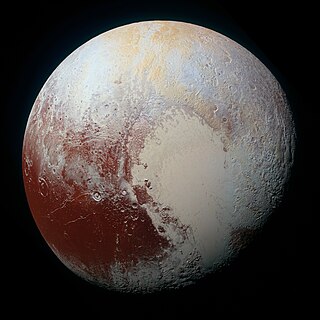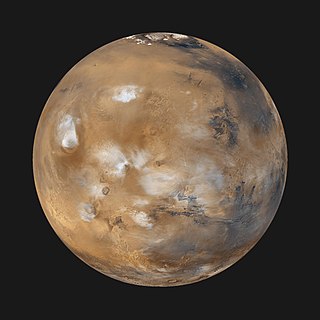
An impact crater is a circular depression in the surface of a solid astronomical body formed by the hypervelocity impact of a smaller object. In contrast to volcanic craters, which result from explosion or internal collapse, impact craters typically have raised rims and floors that are lower in elevation than the surrounding terrain. Impact craters range in size from microscopic craters seen on lunar rocks returned by the Apollo Program to simple bowl-shaped depressions and vast, complex, multi-ringed impact basins. Meteor Crater is a well-known example of a small impact crater on Earth.

Planetary nomenclature, like terrestrial nomenclature, is a system of uniquely identifying features on the surface of a planet or natural satellite so that the features can be easily located, described, and discussed. Since the invention of the telescope, astronomers have given names to the surface features they have discerned, especially on the Moon and Mars. To found an authority on planetary nomenclature, the International Astronomical Union (IAU) was organized in 1919 to designate and standardize names for features on Solar System bodies.

Titan is the largest moon of Saturn and the second-largest in the Solar System. It is the only moon known to have an atmosphere denser than the Earth's, and is the only known object in space other than Earth on which clear evidence of stable bodies of surface liquid has been found. Titan is one of the seven gravitationally rounded moons of Saturn and the second-most distant among them. Frequently described as a planet-like moon, Titan is 50% larger than Earth's Moon and 80% more massive. It is the second-largest moon in the Solar System after Jupiter's moon Ganymede, and is larger than Mercury, but only 40% as massive due to Mercury being made of mostly dense iron and rock, while a large portion of Titan is made of less-dense ice.

Rhea is the second-largest moon of Saturn and the ninth-largest moon in the Solar System, with a surface area that is comparable to the area of Australia. It is the smallest body in the Solar System for which precise measurements have confirmed a shape consistent with hydrostatic equilibrium. It was discovered in 1672 by Giovanni Domenico Cassini.

Tethys, or Saturn III, is the fifth-largest moon of Saturn, measuring about 1,060 km (660 mi) across. It was discovered by Giovanni Domenico Cassini in 1684, and is named after the titan Tethys of Greek mythology.

Hyperion, also known as Saturn VII, is the eighth-largest moon of Saturn. It distinguished by its highly irregular shape, chaotic rotation, low density, and its unusual sponge-like appearance. It was the first non-rounded moon to be discovered.

Enceladus is the sixth-largest moon of Saturn and the 19th-largest in the Solar System. It is about 500 kilometers in diameter, about a tenth of that of Saturn's largest moon, Titan. It is mostly covered by fresh, clean ice, making it one of the most reflective bodies of the Solar System. Consequently, its surface temperature at noon reaches only −198 °C, far colder than a light-absorbing body would be. Despite its small size, Enceladus has a wide variety of surface features, ranging from old, heavily cratered regions to young, tectonically deformed terrain.

Mimas, also designated Saturn I, is the seventh-largest natural satellite of Saturn. With a mean diameter of 396.4 kilometres or 246.3 miles, Mimas is the smallest astronomical body known to be roughly rounded in shape due to its own gravity. Mimas's low density, 1.15 g/cm3, indicates that it is composed mostly of water ice with only a small amount of rock, and study of Mimas's motion suggests that it may have a liquid ocean beneath its surface ice. The surface of Mimas is heavily cratered and shows little signs of recent geological activity. A notable feature of Mimas's surface is Herschel, one of the largest craters relative to the size of the parent body in the Solar System. Herschel measures 139 kilometres across, about one-third of Mimas's mean diameter, and formed from an extremely energetic impact event. The crater's name is derived from the discoverer of Mimas, William Herschel, in 1789. The moon's presence has created one of the largest 'gaps' in Saturn's ring, named the Cassini Division, due to orbital resonance destabilizing the particles' orbit there.

Titania, also designated Uranus III, is the largest of the moons of Uranus. At a diameter of 1,578 kilometres (981 mi) it is the eighth largest moon in the Solar System, with a surface area comparable to that of Australia. Discovered by William Herschel in 1787, it is named after the queen of the fairies in Shakespeare's A Midsummer Night's Dream. Its orbit lies inside Uranus's magnetosphere.

The moons of Saturn are numerous and diverse, ranging from tiny moonlets only tens of meters across to the enormous Titan, which is larger than the planet Mercury. There are 146 moons with confirmed orbits, the most of any planet in the solar system. This number does not include the many thousands of moonlets embedded within Saturn's dense rings, nor hundreds of possible kilometer-sized distant moons that were seen through telescopes but not recaptured. Seven Saturnian moons are large enough to have collapsed into a relaxed, ellipsoidal shape, though only one or two of those, Titan and possibly Rhea, are currently in hydrostatic equilibrium. Three moons are particularly notable. Titan is the second-largest moon in the Solar System, with a nitrogen-rich Earth-like atmosphere and a landscape featuring river networks and hydrocarbon lakes. Enceladus emits jets of ice from its south-polar region and is covered in a deep layer of snow. Iapetus has contrasting black and white hemispheres as well as an extensive ridge of equatorial mountains among the tallest in the solar system.
This is a directory of lists of geological features on planets excepting Earth, moons and asteroids ordered by increasing distance from the Sun.
The naming of moons has been the responsibility of the International Astronomical Union's committee for Planetary System Nomenclature since 1973. That committee is known today as the Working Group for Planetary System Nomenclature (WGPSN).

Odysseus is the largest crater on Saturn's moon Tethys. It is 445 km across, more than 2/5 of the moon's diameter, and is one of the largest craters in the Solar System. It is situated in the western part of the leading hemisphere of the moon—the latitude and longitude of its center are 32.8°N and 128.9°W, respectively. It is named after the Greek hero Odysseus from Homer's the Iliad and the Odyssey.
There are several impact craters named Herschel in the Solar System, although the best known is the huge crater on Saturn's moon Mimas. Most are named after the eighteenth-century astronomer William Herschel.

Herschel is a large impact crater in the leading hemisphere of the Saturnian moon Mimas, centered on the equator at 112° longitude. It is named after the 18th-century astronomer William Herschel, who discovered Mimas in 1789.
The Herschel Heights are a complex of nunataks of which Mimas Peak on the east is the highest, located southwest of the Enceladus Nunataks and near the head of Saturn Glacier in southeastern Alexander Island, Antarctica. The eastern part of this feature was photographed by Lincoln Ellsworth, November 23, 1935, in the course of his trans-Antarctic flight and was plotted from the air photos by W.L.G. Joerg. The heights were named by the UK Antarctic Place-Names Committee from association with Mimas and Enceladus, after Sir William Herschel, the British astronomer who discovered these two satellites of Saturn in 1789.

A low-aspect-ratio layered ejecta crater is a class of impact crater found on the planet Mars. This class of impact craters was discovered by Northern Arizona University scientist Professor Nadine Barlow and Dr. Joseph Boyce from the University of Hawaii in October 2013. Barlow described this class of craters as having a "thin-layered outer deposit" surpassing "the typical range of ejecta". "The combination helps vaporize the materials and create a base flow surge. The low aspect ratio refers to how thin the deposits are relative to the area they cover", Barlow said. The scientists used data from continuing reconnaissance of Mars using the old Mars Odyssey orbiter and the Mars Reconnaissance Orbiter. They discovered 139 LARLE craters ranging in diameter from 1.0 to 12.2 km, with 97% of the LARLE craters found poleward of 35N and 40S. The remaining 3% mainly traced in the equatorial Medusae Fossae Formation.
The following outline is provided as an overview of and topical guide to Saturn:











